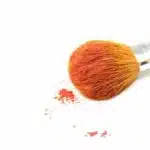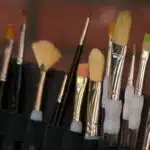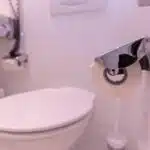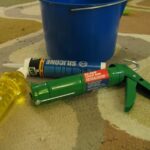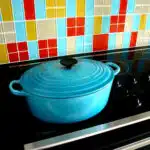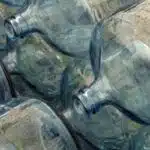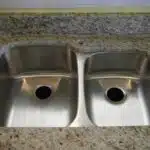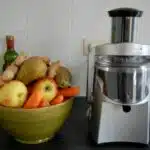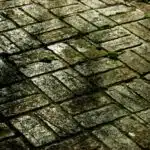Maintaining a clean and hygienic home is essential for ensuring optimal health and well-being. While we often focus on disinfecting surfaces and washing our hands, it is easy to overlook the tools we use to clean such as sponges and scrub brushes. These items can harbor harmful bacteria if not properly sanitized, posing a risk to our health. As a home hygiene expert, I recommend using vinegar as an effective and affordable solution for sanitizing sponges and scrub brushes.
Vinegar has been used as a cleaning agent for centuries due to its natural antibacterial properties. It is an eco-friendly alternative to harsh chemicals and can be used in various ways around the home. When it comes to sanitizing sponges and scrub brushes, vinegar can effectively kill germs and remove odors. In this article, we will explore the benefits of using vinegar for household cleaning, examine how it works as a sanitizer, and provide step-by-step instructions for effectively sanitizing your sponges and scrub brushes with vinegar. By following these simple tips, you can ensure that your cleaning tools are safe to use and help maintain a healthy environment in your home.
The Importance Of Hygiene In The Home
When it comes to maintaining a clean and healthy home, regular cleaning is of utmost importance. Not only does it create a pleasant living environment, but it also prevents the spread of illness. Keeping your home clean ensures that harmful bacteria and viruses are eliminated before they can cause harm to you or your family. This is especially important in high traffic areas such as the kitchen and bathroom.
It’s crucial to understand that cleanliness is not just about appearance. In fact, there are numerous health benefits to maintaining a clean home. Clean surfaces reduce the risk of infections such as colds, flu, and food poisoning. Regular cleaning helps to remove allergens like dust and pet dander which can cause respiratory problems for those with allergies or asthma.
By keeping your house clean, you’re also contributing to a healthier community. The spread of illness can be greatly reduced if we all take responsibility for our own hygiene practices. Proper hand washing and regular cleaning of shared surfaces like doorknobs and light switches can go a long way in preventing the spread of germs from person to person. In the next section, we’ll explore some common household cleaning tools that can help you maintain a clean and hygienic home.
Common Household Cleaning Tools
Maintaining a clean and hygienic home is essential for keeping your family healthy. One way to ensure that your home stays clean is by using proper cleaning techniques and materials. Using the right tools can make all the difference in your cleaning routine, especially when it comes to common household items like sponges and scrub brushes.
Sponges and scrub brushes are often used to clean dishes, countertops, and other surfaces in your home. However, they can easily become breeding grounds for bacteria and germs if not properly sanitized. To prevent the spread of harmful pathogens, it’s important to regularly sanitize your sponges and scrub brushes.
One effective method of sanitizing these items is by using vinegar. Simply soak your sponge or brush in a solution of equal parts water and vinegar for at least five minutes. Rinse thoroughly with water and allow to air dry completely before use. Vinegar is a natural disinfectant that can help kill bacteria, viruses, and other harmful microorganisms while also removing odors from your cleaning tools. By incorporating this simple technique into your cleaning routine, you can help keep your home safe from harmful germs and bacteria.
Bacteria And Germs In Sponges And Scrub Brushes
Sponges and scrub brushes are essential items in any household. They help us keep our homes clean and shiny. However, these cleaning tools can harbor some of the most common bacteria types, such as E. coli, Salmonella, and Staphylococcus aureus. If not sanitized properly, they could pose health risks to your family members.
E. coli is a bacterium that causes food poisoning and gastrointestinal infections. Salmonella is another type of bacteria that causes food poisoning. Staphylococcus aureus is a bacterium that can cause skin infections and respiratory diseases. These bacteria types can survive on sponges and scrub brushes for days or weeks if they are not cleaned thoroughly.
Using contaminated sponges or scrub brushes to clean kitchen counters or dishes could spread harmful bacteria to other surfaces, increasing the risk of infection. Therefore, it’s crucial to sanitize your cleaning tools regularly to eliminate these health risks. In the subsequent section, we will discuss why vinegar is an effective sanitizer for sponges and scrub brushes, an affordable and natural alternative to harsh chemicals that might damage your cleaning tools over time.
Why Vinegar Is An Effective Sanitizer
Bacteria and germs are often found in sponges and scrub brushes, making them a potential source of contamination in the kitchen. As a home hygiene expert, it is important to know how to effectively sanitize these items to prevent the spread of harmful microorganisms. One natural and effective way to do this is by using vinegar.
Vinegar has long been known for its benefits in personal hygiene as well as food preparation. It contains acetic acid which has been shown to have antimicrobial properties. When used as a disinfectant, vinegar can help kill bacteria, viruses, and other pathogens that may be lurking on your sponges and scrub brushes.
To use vinegar as a natural sanitizer for your cleaning tools, start by soaking them in a solution of equal parts water and vinegar for at least 5 minutes. After soaking, rinse thoroughly with water and allow them to air dry completely before using again. This method can also be used to sanitize other household items such as cutting boards, countertops, and even fruits and vegetables.
In addition to being an effective disinfectant, using vinegar for household cleaning also has other benefits. It is non-toxic, environmentally friendly, and cost-effective compared to many commercial cleaning products. By incorporating vinegar into your cleaning routine, you can maintain a clean and healthy home without exposing yourself or your family to harmful chemicals.
The Benefits Of Using Vinegar For Household Cleaning
Vinegar has long been touted as a natural solution for household cleaning. Its acidic properties make it an effective disinfectant, which is why it’s often used to sanitize sponges and scrub brushes. But vinegar has many other benefits beyond just its ability to kill germs.
One of the most significant benefits of using vinegar for household cleaning is that it’s non-toxic and environmentally friendly. Unlike harsh chemical cleaners, vinegar won’t harm your indoor air quality or leave behind harmful residues on surfaces. Plus, it’s much cheaper than many commercial cleaning products, making it an attractive option for those on a budget.
Another way to use vinegar in your home is for laundry. Adding a cup of vinegar to the rinse cycle can help remove odors and brighten clothes without the use of fabric softeners or dryer sheets. Vinegar can also help prolong the life of your washing machine by preventing mineral buildup in the hoses and pipes.
In summary, vinegar is a versatile and affordable solution for many household cleaning needs. From disinfecting surfaces to freshening up laundry, there are countless ways to incorporate this natural cleaner into your routine. In the next section, we’ll delve deeper into the science behind vinegar as a sanitizer and how it works to keep your home clean.
Understanding The Science Behind Vinegar As A Sanitizer
Euphemistically speaking, keeping a clean home is an essential aspect of daily life. This includes ensuring that all surfaces and tools are sanitized to prevent the spread of bacteria and viruses. One of the most commonly used natural sanitizers is vinegar. Understanding the science behind vinegar as a sanitizer can help you make informed decisions when it comes to your home hygiene.
Vinegar composition plays a significant role in its effectiveness as a sanitizer. Vinegar is a diluted acetic acid solution with a pH level of around 2.4-3.0, making it acidic enough to kill many types of bacteria and viruses. Additionally, vinegar has antimicrobial properties due to the presence of acetic acid, which can penetrate bacterial cell walls and disrupt their functions.
When compared to other sanitizers, such as bleach or hydrogen peroxide, vinegar has some advantages. For example, vinegar does not contain harmful chemicals that may pose health risks when inhaled or ingested accidentally. It is also biodegradable and environmentally friendly. However, it should be noted that vinegar may not be effective against certain types of bacteria or viruses, such as those causing foodborne illnesses.
Transitioning into the subsequent section about how to prepare vinegar solution for sanitizing: To effectively use vinegar as a sanitizer for sponges and scrub brushes, it is important to know how to prepare the solution properly.
How To Prepare Vinegar Solution For Sanitizing
Understanding the Science Behind Vinegar as a Sanitizer is crucial before delving into the process of sanitizing sponges and scrub brushes. Vinegar, known for its acidic properties, has long been used as an effective cleaning agent due to its ability to kill bacteria and viruses. It works by breaking down the cell membranes of these microorganisms, rendering them harmless.
To prepare vinegar solution for sanitizing, it is important to first determine the desired Vinegar concentration and soaking duration. A 5% acetic acid concentration is recommended for general household cleaning purposes, but a higher concentration may be needed for more stubborn stains or heavily soiled items. Soaking duration should also be considered, with a minimum of five minutes being recommended to ensure maximum effectiveness.
When sanitizing sponges and scrub brushes with vinegar, it is important to follow a step-by-step guide to ensure proper sanitation. This includes thoroughly rinsing the item under running water before soaking in the vinegar solution for the recommended time period. Once soaked, rinse again thoroughly under running water before air-drying or using immediately if needed. By following these steps and using vinegar as a sanitizer, you can effectively eliminate harmful bacteria and viruses from your sponges and scrub brushes.
Step-By-Step Guide For Sanitizing Sponges With Vinegar
Sponges are an essential tool for kitchen cleaning, but they can harbor harmful bacteria if not sanitized properly. Fortunately, DIY cleaning solutions can help reduce the risk of contamination. One such solution is vinegar, a natural disinfectant that can effectively kill germs on sponges and other surfaces.
To sanitize sponges with vinegar, first rinse them thoroughly with water to remove any debris or food particles. Then, fill a container with equal parts water and white vinegar. Soak the sponge in the solution for at least five minutes, making sure it is fully submerged. After soaking, rinse the sponge again with water and wring out excess moisture before using or storing it.
Using vinegar as a natural disinfectant is a simple and cost-effective way to keep your sponges clean and free from harmful bacteria. Regularly sanitizing your sponges will help prevent cross-contamination in your kitchen and promote better hygiene practices overall. With this easy method, you can enjoy peace of mind knowing that your kitchen tools are safe and sanitary.
Transition: Now that we have covered how to sanitize sponges with vinegar let’s move on to how to sanitize scrub brushes using the same natural disinfectant.
Step-By-Step Guide For Sanitizing Scrub Brushes With Vinegar
To ensure that your cleaning tools are free from harmful bacteria, it is important to sanitize them regularly. In the previous section, we discussed the step-by-step guide for sanitizing sponges with vinegar. Now, let’s move on to scrub brushes.
Step-by-Step Guide for Sanitizing Scrub Brushes with Vinegar:
- Fill a container with equal parts white vinegar and hot water.
- Soak the scrub brush in the solution for at least 30 minutes.
- Rinse the brush thoroughly with hot water.
- Allow it to air dry completely before using again.
- Repeat this process every few weeks or when necessary.
Safety precautions must be taken when handling vinegar. It is important to always wear gloves when handling cleaning solutions and avoid mixing vinegar with bleach or ammonia-based products as this can produce harmful fumes. Additionally, make sure to keep the cleaning solution out of reach of children and pets.
Alternative solutions for sanitizing cleaning tools include using hydrogen peroxide or a mixture of baking soda and water. However, it is important to do research on these methods beforehand as they may not be suitable for all types of cleaning tools. Always follow instructions carefully and take necessary safety precautions when handling any type of cleaning solution.
In summary, keeping your cleaning tools sanitized is crucial in maintaining a healthy living space. By following these simple steps and taking necessary safety precautions, you can ensure that your scrub brushes are free from harmful bacteria and ready to use whenever you need them. If you prefer alternative methods for sanitizing your cleaning tools, there are various options available but make sure to research beforehand and take necessary precautions.
Alternative Methods For Sanitizing Cleaning Tools
There are other methods for sanitizing cleaning tools aside from using vinegar. One of these is through DIY cleaning solutions that use natural disinfectants such as lemon juice, baking soda, and essential oils. These ingredients have antimicrobial properties that can effectively kill germs and bacteria.
For instance, lemon juice contains citric acid that can break down the cell walls of microorganisms, making them more vulnerable to disinfection. Baking soda, on the other hand, has an alkaline pH that can neutralize acidic compounds in dirt and grime. Essential oils like tea tree oil and lavender oil also have antibacterial properties that can eliminate harmful microbes.
Another alternative method is to use high heat or steam to sanitize cleaning tools. This technique can be done by boiling water and submerging the cleaning tool in it for a few minutes or by using a steam cleaner. High temperatures can kill bacteria and viruses effectively without using any chemical disinfectant.
By knowing these alternative methods for sanitizing cleaning tools, you’ll be able to choose what works best for you and your household needs. In the next section, we’ll discuss some tips on how to maintain clean and sanitized cleaning tools regularly.
Tips For Maintaining Clean And Sanitized Cleaning Tools
- Sponges are a commonly used cleaning tool and should be disinfected regularly to maintain a sanitized environment.
- To sanitize sponges, they should be soaked in a mixture of one part white vinegar to four parts of warm water for five minutes.
- Scrub brushes are another essential cleaning tool, and they can be disinfected by soaking them in a solution of half white vinegar and half hot water for 30 minutes.
- After soaking, both sponges and scrub brushes should be rinsed with warm water and allowed to air dry before being reused.
Sanitizing Sponges
Maintaining clean and sanitized cleaning tools is essential to prevent the spread of bacteria and germs. Sponges and scrub brushes are commonly used in households, but they can quickly become breeding grounds for harmful bacteria if not sanitized regularly. One effective method for sanitizing sponges and scrub brushes is by using vinegar.
To sanitize sponges, start by rinsing them thoroughly with hot water. Then fill a bowl or sink with equal parts water and vinegar. Soak the sponge in this solution for at least five minutes. For a deeper clean, microwave the sponge for one minute after soaking it in the vinegar solution. By doing so, you will kill off any remaining bacteria on the sponge’s surface.
Another way to maintain clean sponges is by using DIY sponge holders that allow them to dry out between uses. These holders can be made from simple materials like plastic mesh or old stockings. It’s also important to replace sponges regularly, ideally every two weeks, especially if they have been heavily used or show signs of wear and tear. With these tips, you can ensure that your cleaning tools are always hygienic and ready to use when needed without compromising your household’s health.
Sanitizing Scrub Brushes
Maintaining clean and sanitized cleaning tools is crucial to keep our homes free from harmful bacteria and germs. While we discussed the importance of sanitizing sponges in the previous subtopic, it’s equally vital to sanitize scrub brushes regularly. Scrub brushes are commonly used for cleaning surfaces like dishes, floors, and bathrooms, making them a breeding ground for bacteria if not sanitized properly.
To sanitize scrub brushes, start by rinsing them thoroughly with hot water. Then fill a bowl or sink with equal parts water and vinegar and add a few drops of dish soap. Soak the brush in this solution for at least five minutes, ensuring that all bristles are covered in the solution. Rinse the brush thoroughly under running water to remove any remaining vinegar solution.
It’s essential to replace scrub brushes every two to three months or when they show signs of wear and tear. Using DIY holders made of materials like plastic mesh or old stockings can help keep scrub brushes dry between uses, preventing bacterial growth. By following these tips for scrub brush maintenance and sponge replacement frequency, we can ensure that our cleaning tools remain hygienic and effective in keeping our homes clean and safe for our loved ones.
Other Uses For Vinegar In The Home
When we think of vinegar, we often associate it with cooking or cleaning. However, vinegar has many other uses and benefits in the home. One of the most popular uses for vinegar is as a natural fabric softener. It not only softens clothes but also helps to remove any lingering odors. Simply add a cup of vinegar to the rinse cycle in your washing machine.
Another benefit of vinegar is its ability to remove stains from carpets and upholstery. Mix equal parts water and vinegar and apply it to the stained area with a cloth or sponge. Let it sit for a few minutes before blotting away with a clean cloth. Repeat until the stain is gone.
In addition to these household uses, vinegar can be used in many other ways around your home. For example, you can use it to remove soap scum in your bathroom or as an all-purpose cleaner in your kitchen. With so many benefits, it’s no wonder that vinegar is considered a must-have item in any household cleaning arsenal.
As we become more conscious of our impact on the environment, eco-friendly cleaning alternatives are becoming increasingly popular. In the next section, we will explore some of these alternatives and how they can help you keep your home clean while reducing your carbon footprint.
Eco-Friendly Cleaning Alternatives
Continuing on the topic of Other Uses for Vinegar in the Home, let’s explore more ways to incorporate Green Cleaning and Sustainable Solutions. With the increasing awareness of environmental issues, people are looking for Natural Disinfection and Safe Practices to keep their homes clean. Using vinegar as a cleaning agent has been a popular method for years due to its effectiveness and affordability.
One eco-friendly alternative to traditional cleaning products is using baking soda and vinegar together. Baking soda neutralizes odors while vinegar disinfects surfaces, making them an ideal combination for natural cleaning. Another option is incorporating essential oils into your cleaning routine. Not only do they provide a pleasant scent, but certain oils like tea tree oil have antimicrobial properties that can help kill germs.
When it comes to home hygiene, it’s important to know common myths and misconceptions about vinegar. One such myth is that vinegar can be used on any surface without causing damage. While vinegar is safe for many surfaces, it should not be used on stone countertops or hardwood floors as it can cause etching or damage the finish. Additionally, vinegars with high acidity levels should be diluted before use to prevent damage.
As we continue on our journey towards sustainable living, incorporating green cleaning solutions into our daily routines can make a significant impact on the environment. By utilizing natural disinfection methods like vinegar and safe practices such as proper dilution ratios, we can keep our homes clean while also protecting our planet.
Common Myths And Misconceptions About Vinegar
Vinegar is an acidic compound, but it has a lower pH than many other cleaning products, making it an effective, yet mild cleaner. It is important to be aware that vinegar should not be used on all surfaces, as it can cause damage to certain materials. Despite the common misconception that vinegar has no sanitizing properties, it has been proven to be effective in killing some bacteria and other germs, making it a viable option for sanitizing sponges and scrub brushes. It is recommended that vinegar be diluted with water before use, to reduce its potency and protect surfaces from damage. Furthermore, it is important to note that vinegar should not be used as a replacement for disinfecting products that are specifically designed to kill germs. Finally, it is important to keep in mind that vinegar alone is not enough to ensure a thorough cleaning and sanitizing of a surface.
Myth: Vinegar Is Too Acidic
Have you ever heard the myth that vinegar is too acidic to be an effective sanitizer? Well, let me tell you, this couldn’t be further from the truth. In fact, vinegar has been used for centuries as a natural disinfectant due to its high acidity level. It has been proven through scientific research that vinegar can effectively kill bacteria and viruses on surfaces, making it a great alternative to harsh chemical cleaners.
When it comes to sanitizing agents, vinegar is actually one of the best options available. Not only is it non-toxic and eco-friendly, but it’s also very affordable and readily available at any grocery store. In comparison to other sanitizers such as bleach or hydrogen peroxide, vinegar is much gentler and won’t damage surfaces or cause harm if ingested accidentally. Plus, it doesn’t leave behind any harsh chemical smells or residues.
So next time you need to sanitize your sponges or scrub brushes, don’t be afraid to use vinegar as your go-to cleaning agent. Just mix equal parts water and white vinegar in a spray bottle and spritz generously onto the surface you want to sanitize. Let it sit for a few minutes before rinsing thoroughly with water. You’ll be amazed at how clean and fresh-smelling your items will be!
Misconception: Vinegar Can Be Used On All Surfaces
Cleaning misconceptions can lead to the improper use of cleaning agents, which can be harmful to both people and surfaces. One common misconception about vinegar as a natural disinfectant is that it can be used on all surfaces. However, this is not entirely true. While vinegar is an effective cleaning agent, it has limitations in terms of what types of surfaces it can be used on.
As a home hygiene expert, I strongly advise against using vinegar on certain surfaces such as marble or granite countertops, hardwood floors, and some types of metals like cast iron or aluminum. The high acidity level in vinegar can cause etching on natural stone surfaces, damage the finish on hardwood floors, and corrode certain metals. It’s important to always check the manufacturer’s instructions before using any cleaning agent on any surface.
While vinegar is an eco-friendly and affordable option for sanitizing surfaces around your home, it’s vital to know its limitations when it comes to what types of surfaces you can use it on. Avoiding the use of vinegar on certain materials will prevent damage and help prolong their lifespan. Always remember to read the label instructions carefully before applying any cleaning solution to avoid unwanted consequences and ensure proper care for your valuable belongings.
Myth: Vinegar Has No Sanitizing Properties
The vinegar sanitizing debate is a long-standing controversy in the world of home hygiene. Many people swear by vinegar as a natural disinfectant, while others remain skeptical about its effectiveness. One common myth about vinegar is that it has no sanitizing properties. However, this couldn’t be further from the truth. Vinegar has been proven to kill certain bacteria and viruses, making it a viable option for sanitizing surfaces around your home.
As a home hygiene expert, I can attest to the fact that vinegar does have sanitizing properties. Research has shown that white vinegar can effectively kill up to 80% of germs, including E.coli and salmonella. While it may not be as potent as commercial disinfectants, vinegar can still provide an eco-friendly and affordable solution for keeping your home clean and safe.
Despite its effectiveness as a sanitizer, it’s important to note that vinegar may not be suitable for all types of germs or surfaces. Additionally, some experts recommend using higher concentrations of vinegar or combining it with other ingredients like hydrogen peroxide for maximum effectiveness. As with any cleaning agent, it’s crucial to read label instructions carefully and use caution when applying to avoid unwanted consequences.
Conclusion: Keeping Your Home Clean And Healthy With Vinegar
Vinegar, with its acidic properties, has been a trusted cleaning agent for centuries. It has been used in various ways to sanitize and disinfect homes. The benefits of vinegar are numerous, making it an affordable and safer alternative to other cleaning products.
One of the advantages of using vinegar is that it is eco-friendly. Unlike toxic chemicals found in most cleaning products, vinegar is biodegradable and does not harm the environment. It also produces fewer fumes and does not pose a health risk compared to other cleaning agents. Furthermore, vinegar can be used for multiple purposes at home, such as laundry, kitchen, bathroom, and even gardening.
Vinegar vs other cleaning products is a debate that continues to rage on. However, studies have shown that vinegar is equally effective in killing bacteria and germs as other commercial cleaners. Additionally, it is cheaper than most cleaning agents available in the market today. By using vinegar-based solutions for your household chores instead of harsh chemicals, you will be able to maintain a healthy environment while saving money.
Conclusion
Maintaining a clean and healthy home is crucial to the well-being of you and your loved ones. Household cleaning tools such as sponges and scrub brushes are essential for keeping our homes clean, but they can also harbor harmful bacteria and germs. This is where vinegar comes in as an effective sanitizer.
Vinegar has been used for centuries as a natural cleaning agent due to its acidity that helps kill bacteria and germs. It is a safe and affordable alternative to harsh chemical cleaners, making it an ideal choice for those who want to keep their homes clean without harming the environment.
While vinegar is commonly used for sanitizing sponges and scrub brushes, it also has other uses in the home such as removing stains, deodorizing fabrics, and even repelling insects. However, there are some common misconceptions about vinegar that should be addressed. Contrary to popular belief, not all types of vinegar are created equal when it comes to cleaning. Also, while vinegar is effective at killing some types of bacteria, it may not be suitable for all cleaning tasks.
In conclusion, incorporating vinegar into your household cleaning routine can help keep your home clean and healthy while also being eco-friendly. By understanding its benefits and limitations, you can make informed decisions on how best to use this natural cleaning agent in your home. With proper hygiene practices and the power of vinegar on your side, you can create a happy and healthy living space for you and your family.
Image Credits



